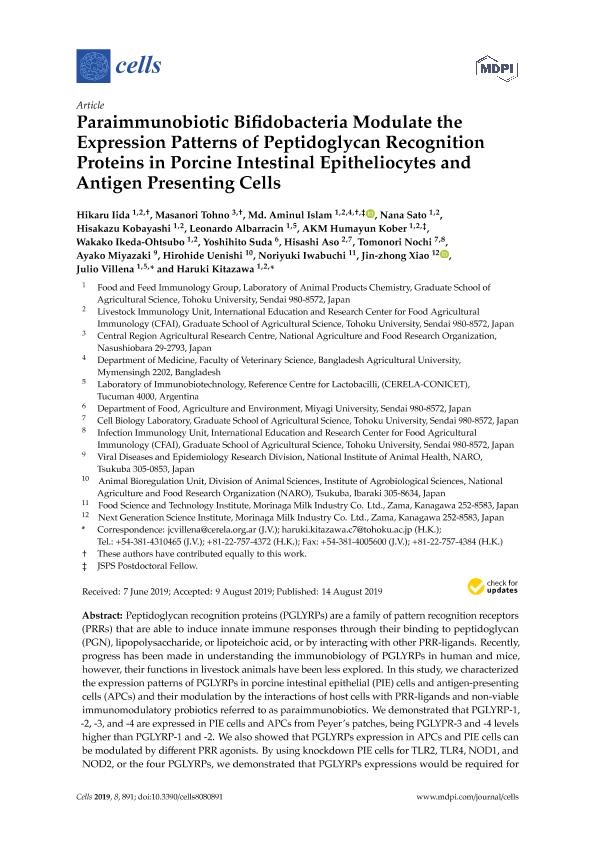Mostrar el registro sencillo del ítem
dc.contributor.author
Iida, Hikaru
dc.contributor.author
Tohno, Masanori
dc.contributor.author
Islam, Md. Aminul
dc.contributor.author
Sato, Nana
dc.contributor.author
Kobayashi, Hisakazu
dc.contributor.author
Albarracín, Leonardo Miguel

dc.contributor.author
Humayun Kober, AKM
dc.contributor.author
Ikeda-Ohtsubo, Wakako
dc.contributor.author
Suda, Yoshihito
dc.contributor.author
Aso, Hisashi
dc.contributor.author
Nochi, Tomonori
dc.contributor.author
Miyazaki, Ayako
dc.contributor.author
Uenishi, Hirohide
dc.contributor.author
Iwabuchi, Noriyuki
dc.contributor.author
Xiao, Jin-zhong
dc.contributor.author
Villena, Julio Cesar

dc.contributor.author
Kitazawa, Haruki
dc.date.available
2020-02-11T18:03:58Z
dc.date.issued
2019-08-14
dc.identifier.citation
Iida, Hikaru; Tohno, Masanori; Islam, Md. Aminul; Sato, Nana; Kobayashi, Hisakazu; et al.; Paraimmunobiotic bifidobacteria modulate the expression patterns of peptidoglycan recognition proteins in porcine intestinal epitheliocytes and antigen presenting ells; MDPI; Cells; 8; 8; 14-8-2019; 1-22;891-891
dc.identifier.issn
2073-4409
dc.identifier.uri
http://hdl.handle.net/11336/97175
dc.description.abstract
Peptidoglycan recognition proteins (PGLYRPs) are a family of pattern recognition receptors (PRRs) that are able to induce innate immune responses through their binding to peptidoglycan (PGN), lipopolysaccharide, or lipoteichoic acid, or by interacting with other PRR-ligands. Recently, progress has been made in understanding the immunobiology of PGLYRPs in human and mice, however, their functions in livestock animals have been less explored. In this study, we characterized the expression patterns of PGLYRPs in porcine intestinal epithelial (PIE) cells and antigen-presenting cells (APCs) and their modulation by the interactions of host cells with PRR-ligands and non-viable immunomodulatory probiotics referred to as paraimmunobiotics. We demonstrated that PGLYRP-1, -2, -3, and -4 are expressed in PIE cells and APCs from Peyer?s patches, being PGLYPR-3 and -4 levels higher than PGLYRP-1 and -2. We also showed that PGLYRPs expression in APCs and PIE cells can be modulated by different PRR agonists. By using knockdown PIE cells for TLR2, TLR4, NOD1, and NOD2, or the four PGLYRPs, we demonstrated that PGLYRPs expressions would be required for activation and functioning of TLR2, TLR4, NOD1, and NOD2 in porcine epitheliocytes, but PGLYRPs activation would be independent of those PRR expressions. Importantly, we reported for the first time that PGLYRPs expression can be differentially modulated by paraimmunobiotic bifidobacteria in a strain-dependent manner. These results provide evidence for the use of paraimmunobiotic bifidobacteria as an alternative for the improvement of resistance to intestinal infections or as therapeutic tools for the reduction of the severity of inflammatory damage in diseases in which a role of PGLYRPs-microbe interaction has been demonstrated.
dc.format
application/pdf
dc.language.iso
eng
dc.publisher
MDPI
dc.rights
info:eu-repo/semantics/openAccess
dc.rights.uri
https://creativecommons.org/licenses/by-nc-sa/2.5/ar/
dc.subject
PARAIMMUNOBIOTICS
dc.subject
PEPTIDOGLYCAN RECOGNITION PROTEIN
dc.subject
BIFIDOBACTERIA
dc.subject
INNATE IMMUNITY
dc.subject
PORCINE INTESTINAL EPITHELIOCYTES
dc.subject
PORCINE ANTIGEN-PRESENTING CELLS
dc.subject.classification
Inmunología

dc.subject.classification
Medicina Básica

dc.subject.classification
CIENCIAS MÉDICAS Y DE LA SALUD

dc.title
Paraimmunobiotic bifidobacteria modulate the expression patterns of peptidoglycan recognition proteins in porcine intestinal epitheliocytes and antigen presenting ells
dc.type
info:eu-repo/semantics/article
dc.type
info:ar-repo/semantics/artículo
dc.type
info:eu-repo/semantics/publishedVersion
dc.date.updated
2019-12-11T20:15:06Z
dc.journal.volume
8
dc.journal.number
8
dc.journal.pagination
1-22;891-891
dc.journal.pais
Suiza

dc.journal.ciudad
Basel
dc.description.fil
Fil: Iida, Hikaru. Tohoku University; Japón
dc.description.fil
Fil: Tohno, Masanori. National Agriculture and Food Research Organization. Central Region Agricultural Research Centre; Japón
dc.description.fil
Fil: Islam, Md. Aminul. Tohoku University; Japón. Agricultural University. Faculty of Veterinary Science. Department of Medicine; Bangladesh
dc.description.fil
Fil: Sato, Nana. Tohoku University; Japón
dc.description.fil
Fil: Kobayashi, Hisakazu. Tohoku University; Japón
dc.description.fil
Fil: Albarracín, Leonardo Miguel. Tohoku University; Japón. Consejo Nacional de Investigaciones Científicas y Técnicas. Centro Científico Tecnológico Conicet - Tucumán. Centro de Referencia para Lactobacilos; Argentina
dc.description.fil
Fil: Humayun Kober, AKM. Tohoku University; Japón
dc.description.fil
Fil: Ikeda-Ohtsubo, Wakako. Tohoku University; Japón
dc.description.fil
Fil: Suda, Yoshihito. Miyagi University. Department of Food, Agriculture and Environment; Japón
dc.description.fil
Fil: Aso, Hisashi. Tohoku University; Japón
dc.description.fil
Fil: Nochi, Tomonori. Tohoku University; Japón
dc.description.fil
Fil: Miyazaki, Ayako. National Institute of Animal Health. Viral Diseases and Epidemiology Research Division; Japón
dc.description.fil
Fil: Uenishi, Hirohide. National Agriculture And Food Research Organization; Japón
dc.description.fil
Fil: Iwabuchi, Noriyuki. Morinaga Milk Industry Co., Ltd.; Japón
dc.description.fil
Fil: Xiao, Jin-zhong. Morinaga Milk Industry Co., Ltd.; Japón
dc.description.fil
Fil: Villena, Julio Cesar. Consejo Nacional de Investigaciones Científicas y Técnicas. Centro Científico Tecnológico Conicet - Tucumán. Centro de Referencia para Lactobacilos; Argentina. Tohoku University; Japón
dc.description.fil
Fil: Kitazawa, Haruki. Tohoku University; Japón
dc.journal.title
Cells
dc.relation.alternativeid
info:eu-repo/semantics/altIdentifier/url/https://www.mdpi.com/2073-4409/8/8/891
dc.relation.alternativeid
info:eu-repo/semantics/altIdentifier/doi/https://dx.doi.org/10.3390/cells8080891
Archivos asociados
